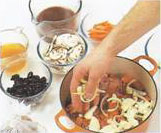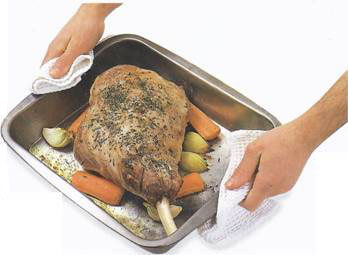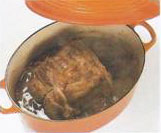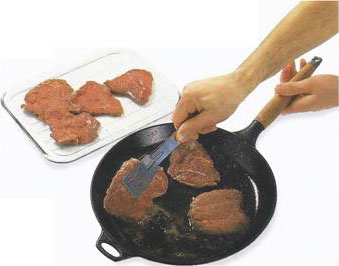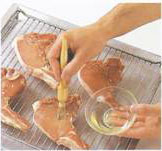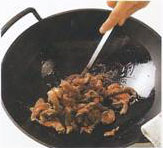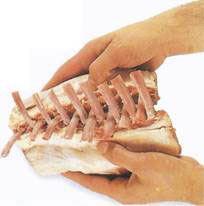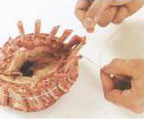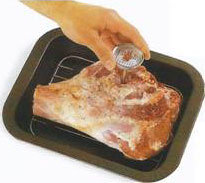|
|
|
MEAT STOCK
Ask your butcher to saw 4 lb (2 kg) bones into 21/2-in (6-cm) pieces. Beef and veal
bones are best.
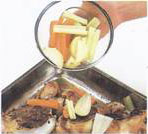
1 Roast the bones in a 450癋 (230癈) oven for about 30 minutes until well browned.
Add 2-3 roughly chopped onions, carrots, and celery stalks. Roast for 30 minutes.
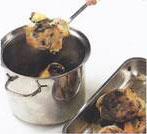
2 Transfer the browned bones and vegetables to a large stockpot. Add 4 quarts (4
liters) water, a bouquet garni made of 1-2 bay leaves, a few paTsley stalks, and
1-2 sprigs of thyme, tied together with fine string, and a few black peppercorns.
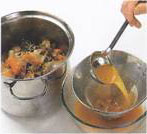
3 Bring to a boil, skim off scum, then simmer for 4-6 hours. Using a ladle, strain
the meat stock. Skim off fat, or let cool and lift off solidified fat.
MEAT KNOW-HOW
FOR CENTURIES, MEAT HAS BEEN the protein food around which the majority of meals
have been planned. And even though more and more people are changing their diets
to include more vegetables, pasta, rice, and beans, meat is still enjoyed by most
families several times a week, and it still forms the traditional centerpiece for
many celebration meals. Make sure the cooking method suits the cut of meat you are
preparing. Lean meats are best cooked quickly, while tougher cuts of meat are made
more tender with long, slow cooking.
BUYING & STORING
If possible, buy your meat from a butcher because he's most likely to have just
the cut you want (or will be prepared to cut it for you), and he will also advise
you how to cook it. Wherever you shop, choose meat that looks fresh and moist (not
wet), with a good color and no grayish tinge. If possible, smell the meat: it should
smell fresh. Check that pieces are neatly trimmed, without excess fat and splinters
of bone. Appetites vary, but as a general guide, allow 4-7 oz (125-200 g) of lean
boneless meat per person and about 8 oz (250 g) per person if the meat has a reasonable
amount of bone.
Store meat, both raw and cooked, in the refrigerator. Ground meat and organ meats
are more perishable than other kinds of meat, so cook them within 1-2 days of purchase.
Chops, steaks, and roasts can be kept for 2-4 days; remove the wrapping and replace
with a loose covering. Eat cooked meat within 2-3 days.
Microwaving
Because microwave cooking is so fast, meat does not have time to brown and become
crisp. This can be overcome by using a special browning dish that sears meat in
the way a skillet does.
The microwave oven is very useful for defrosting frozen meat. This must be done
evenly at the manufacturer's recommended setting to prevent some parts of the meat
beginning to cook before others are totally defrosted. All wrapping should be removed
from the meat before defrosting to ensure that the meat does not start cooking.
|
|
Freezing
Meat to be frozen must be very fresh. Wrap it tightly so that all the air is excluded.
Pad any sharp bones so that they don't pierce the wrapping. If packing chops, cutlets,
steaks, or hamburgers, separate them with freezerproof plastic wrap or freezer paper.
The larger the piece of meat the longer it will keep. Ground meat and sausages can
be stored in the freezer for 3 months; organ meats, chops, and cutlets for 4 months;
roasts and steaks for 6 months. Thaw frozen meat, in its wrapping and Oil a plate
to catch any juices, in the refrigerator.
|
BASIC COOKING TECHNIQUES
Tougher pieces of meat should be cooked slowly by stewing or braising. More Lender
pieces can be cooked quickly by frying or broiling. Beef and lamb when roasted,
broiled, or fried can be served pink in the middle, but pork should be thoroughly
cooked.
Stewing
Cut the meat into cubes. Put into a flameproof casserole with any vegetables and
liquid to cover. Bring to a boil, cover, and simmer on top of the stove or in the
oven.
Alternatively, to seal in juices, heat some oil in the casserole and brown the cubes.
Brown the vegetables, add liquid and flavorings, bring to a boil, cover, and simmer
as above.
Roasting
- Take the meat from the refrigerator and allow it to come to room temperature.
- Preheat the oven. Rub the meat with fat or oil and seasonings or make incisions
all over and insert herbs or slivers of garlic. Insert a meat thermometer, if using.
- Put the meat and any vegetables in a roasting pan. Roast in the preheated oven,
basting with the juices, until cooked to your taste (page 214). If not using a meat
thermometer, test whether the meat is cooked by inserting a skewer into the center.
If the juices that run out are bloody, the meat is rare; if pink, medium; if clear,
well-done.
- Transfer the roast to a carving board and leave to rest for 10-15 minutes while
making gravy. Carve the roast (page 213) and serve.
Braising
- Brown the meat in the casserole to add flavor and to seal in the cooking juices.
Remove the meat from the casserole.
- Add chopped vegetables and cook until beginning to brown. Return the meat and add
liquid and flavorings. Bring to a boil, cover, and cook gently according to the
recipe.
Frying and sauteing
- Dry the meat with paper towels (if too moist, it will not brown quickly and evenly).
Heat oil or a mixture of oil and butter in a heavy skillet until it is very hot
and add the meat, being careful not to crowd the pan.
- Cook until well browned all over. Reduce the heat and continue until the meat is
done to your taste. When turning meat, use tongs rather than a fork since a fork
pierces the meat and allows thejuices to run out.
Broiling and barbecuing
- Preheat the broiler to hot, or light the barbecue (it will take 20-30 minutes to
reach cooking temperature unless it is a gas barbecue, which will heat up immediately).
- Arrange the meat on the broiler pan and put under the broiler, or arrange on the
grid over the charcoal fire. Brush with oil or melted butter and cook the meat until
it is browned all over.
- For sausage or thicker pieces of meat that need to be cooked thoroughly, reduce
the heat or move the meat farther away from the heat and complete cooking.
Stir-frying
- Cut the meat into uniform pieces for even cooking. Heat a wok or heavy skillet,
then add a little oil.
- When the oil is hot, start adding the meat, a little at a time - adding too much
at once will lower the temperature of the oil. Using a slotted spoon or a spatula,
stir and toss the meat constantly until it is evenly browned.
- If some pieces of meat are cooked before others, they can be pushed Lip the side
of the wok or to the side of the pan, where they will stay warm but not overcook.
BONING & BUTTERFLYING A LEG OF LAMB
A boned leg of lamb is much easier to carve than meat still on the bone. Tunnel
boning leaves a pocket that can be filled with stuffing. Cutting the leg open to
lie flat is knoum. as butterflying.
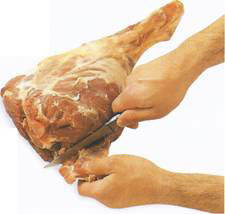
1 To tunnel bone, trim the skin and most or all of the fat from the lamb. Cut around
the pelvic bone, at the wide end of the leg, to separate it from the meat. Sever
the tendons that connect it to the leg bone. Remove the pelvic bone.
|
|
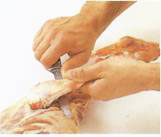
2 At the narrow end of the leg, cut around the shank bone and then scrape the meat
away from the whole length of the bone using short strokes.
|
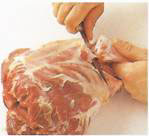
3 Cut away the meat to expose thejoint that joins the shank bone to the leg bone.
Sever the tendons and then remove the shank bone.
|
|
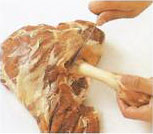
4 Cut around each end of the leg bone. Ease the leg bone out, cutting and scraping
away the meat as you twist and pull it out. Trim off the tendons.
|
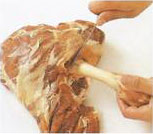
5 If you want to butterfly the boned leg, carefully insert a large chefs knife into
the cavity left by the leg bone and cut to one side to slit open the meat.
|
|
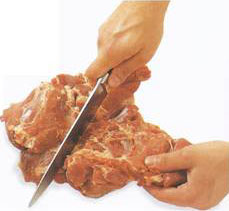
6 Open out the boned leg into a "butterfly" shape. Cut through any thick portions
of meat so that the whole leg can be opened out flatand is roughly even in thickness.
Trim off excess fat and any remaining tendons.
|
BONING A SHOULDER OF LAMB
A special boning knife, with a narrow, pointed blade, is useful for preparing shoulders
af lamb, pork, and veal. If you don't have one, a small, sharp chef's knife can
be used instead
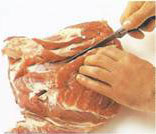
1 Remove the skin and fat. Set the shoulder meat side up. Cut through the meat to
the blade bone, and then cut away the meat on either side, keeping the knife as
close to the bone as possible, until the bone is revealed.
|
|
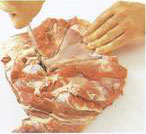
2 Cut through the baJl-and- socket joint between the blade bone and the central
shoulder bone to separate the 2 bones.
|
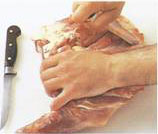
3 Cut beneath the ball-and- socket joint to free the end. Hold it firmly in one
hand and pull the blade bone away from the meat.
|
|
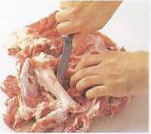
4 Cut around the central shoulder bone, severing the tendons and cutting and scraping
away the meat. Pull out the bone. If necessary, enlarge the pocket left by the bone
so that it will accommodate a stuffing.
|
PREPARING RACK OF LAMB
Rack of lamb is a tender cut for roasting or broiling. A single rack, which is one
side of the upper rib cage, comprises 6-9 cutlets and serves 2-3 people. Two racks
can be used to make impressive cuts such as a guard of honor or a crown roast.
Rack of lamb
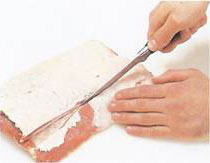
1 Set the rack on a board and cut away the cartilage at one end. Pull off the skin.
Score the fat and meat 2 in (5 cm) from the ends of the rib bones.
|
|
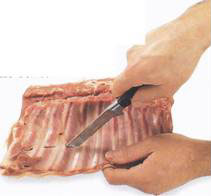
2 Turn the rack over and set it at the edge of the cutting board so the ends of
the rib bones are suspended. Score the meat along the rack, about 2 in (5 cm) from
the ends of the rib bones, cutting through to the bones.
|
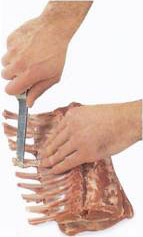
3 Cut out the meat from between the bones, cutting from the crosswise cuts to the
ends. Turn the rack over and scrape the ends of the bones clean.
|
|
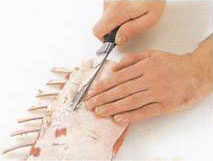
4 Trim away most of the fat from the meat. Repeat the preparation process with the
second rack, if using.
|
Guard of honor
Hold 1 rack in each hand, fat side outward, and push them together, interlocking
the rib bones. Cook as directed, covering the rib bones with foil if desired, to
prevent them from charring during cooking.
STUFFING, ROLLING, & TYING A ROAST
Cuts that have been boned and opened out can be rolled around a stuffing, which
gives both moisture and flavor to the meat during cooking.
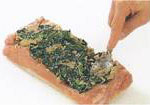
1 Open out the meat and spread with an even layer of stuffing, leaving a small margin
around the edge of the meat.
|
|
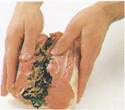
2 Roll up or fold the meat around the stuffing to make a compact bolster shape.
Turn it so that the seam is underneath.
|
|
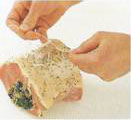
3 Tie string around the meat at regular intervals, to hold it in shape during cooking.
Remove the string before carving.
|
CROWN ROAST
Two racks of lamb are tied together in the shape of a crown.
- Prepare 2 racks as above. Slit the membrane between the rib bones at the meaty end
so that the racks can be bent.
- Stand the racks, meat side innermost, on a work surface and curve to form a crown
shape. Bend the bones so that the crown will stand upright.
- Tie string around the middle of the 2 racks to hold them in place.
- Fill the center of the roast with a stuffing or add a filling just before serving.
Carve the roast by cutting down between the rib bones.
CARVING A ROAST
ROnce a roast has finished cooking, transfer it to a carving board and let it rest
in a warm place for 10-15 minutes. During this time, the temperature of the meat
will even out, and the flesh will reabsorb most of the juices. To carve, use a 2-pronged
carving fork and a long carving knife.
Shoulder of lamb
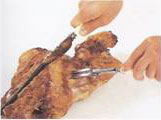
1 Insert the fork into the shank end. Cut a narrow, wedge-shaped piece from the
center, in the meatiest part between the angle formed by the blade bone and the
shoulder bone.
|
|
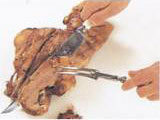
2 Carve neat slices from either side of this wedge- shaped cut until the blade and
central shoulder bones are reached. Turn the shoulder over and cut horizontal slices
lengthwise.
|
Leg of lamb
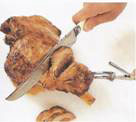
1 Set the roast with the meaty side upward, and insert the carving fork firmly into
the knuckle end. Cut a narrow, wedge-shaped piece from the center of the meaty portion,
cutting all the way to the bone.
|
|
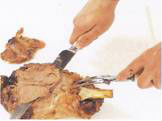
2 Carve neat slices from either side of this wedge- shaped cut, gradually changing
the angle of the knife to make the slices larger. Turn the leg over. Trim off the
fat, then carve off horizontal slices.
|
Beef rib roast
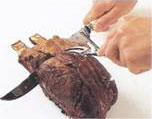
1 Set the roast upright on a carving board, insert the carving fork into the meaty
side to steady the joint, and cut close to the large rib bones at the base of the
meat to remove them.
|
|
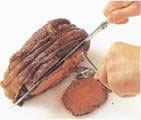
2 With the meat on its side, hold the knife at a slight angle and carve the meat
into slices, 3j 4 in (2 cm) thick.
|
Whole ham
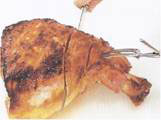
1 Cut a few horizontal slices from one side of the ham to make a flat surface. Turn
the ham over onto this surface. Insert the carving fork in the shank end. Make 3
or 4 cuts through to the bone at the shank end.
|
|
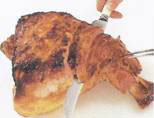
2 Insert the knife into the last cut and slide it along the bone to detach the slices.
Make a few more cuts in the ham and continue to remove the slices in the same way.
Turn over and carve off horizontal slices.
|
MAKING GRAVY
A delicious gravy can be made from a good stock and the richly flavored drippings
left after roasting meat. Be sure to remove most of the fat before you begin.
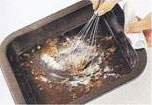
1 Pour all but 1 tbsp fat from the roasting pan, leaving the juices. Set the pan
on top of the stove and heat until sizzling. Stir in 1 tbsp all-purpose flour.
|
|
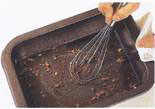
2 Stir briskly to mix the flour with the juices and scrape the bottom and sides
of the pan to dissolve any browned bits. Keep stirring to form a well-browned paste.
|
|
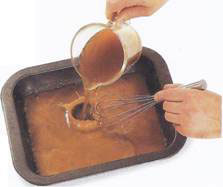
3 Gradually add 1 quart (1 liter) stock or other liquid, whisking constantly to
combine with the flour paste. Whisk until smooth. Simmer, stirring frequently, until
the gravy reaches the desired consistency. Season to taste, strain into a warmed
gravy boat and serve.
|
USING A MEAT THERMOMETER
The most accurate way to test if a large piece of meat is cooked is to use a meat
thermometer, which registers the internal temperature of the meat. Before cooking,
insert the spike of the thermometer into the middle or thickest part of the meat.
Make sure that the thermometer does not touch a bone because bones become hotter
than meat and will therefore give a false reading. Start checking the temperature
reading toward the end of the suggested cooking time. A roast will continue to cook
by retained heat for 5-10 minutes after it is removed from the oven, so take it
out as soon as the thermometer reaches the desired temperature.
PREPARING ORGAN MEATS
Sweetbreads are glands from the throat and heart of calves or lambs. They have a
delicate flavor and a rich, creamy texture. Lamb, beef, and veal kidneys are sometimes
sold surrounded by a layer of hard, white fat - this is suet.
Sweetbreads
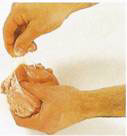
1 Soak the sweetbreads in cold water with 1 tbsp lemon juice for 2-3 hours to clean
them. Drain and rinse well. Cut away any discolored parts. Use your fingers to carefully
peel off the thin membrane surrounding the sweetbreads.
|
|
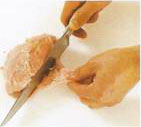
2 Cut away the ducts and any fat and discard. Don't remove too much, or the sweetbreads
will break up. Put into a saucepan of cold water and bring to a boil. Blanch calfs
sweetbreads for 5 minutes, lamb's sweetbreads for 3 minutes.
|
Kidneys
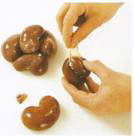
1 If the kidneys are surrounded by suet, pull it away. Separate the kidneys (if
using beef or veal). Carefully cut through the fine membrane around each kidney
and use your fingers to peel it off (cut the ducts from beef or veal kidneys).
|
|
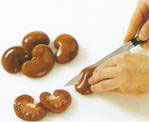
2 Set each kidney rounded side up and slice lengthwise in half (or leave attached
at the base, according to recipe directions). With a sharp pair of scissors, snip
out the small fatty white core and the tubes.
|
|




